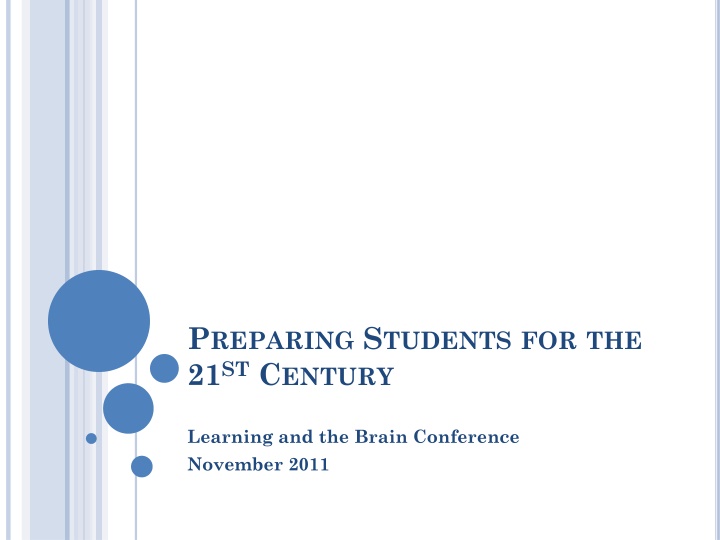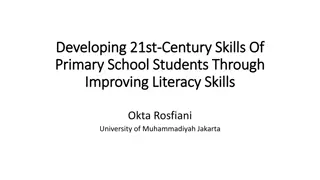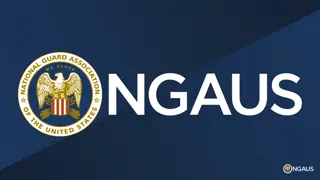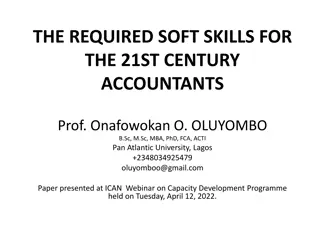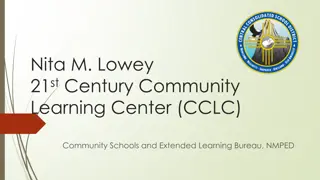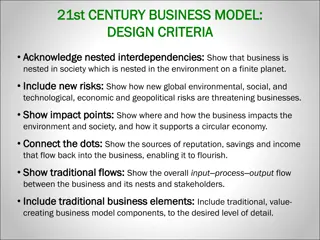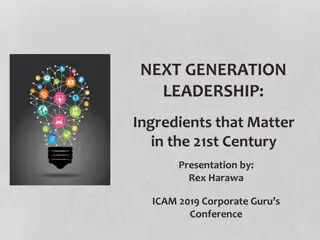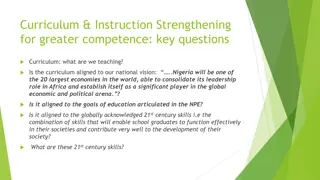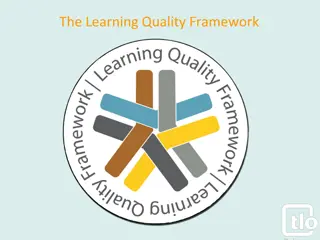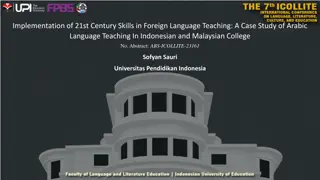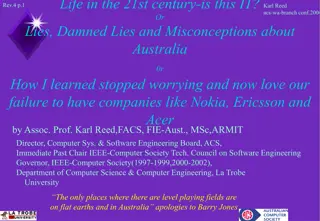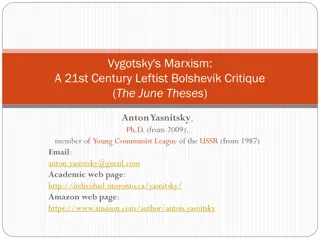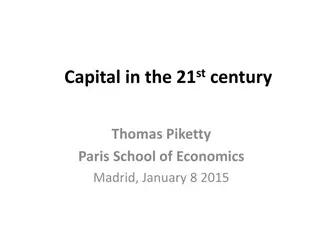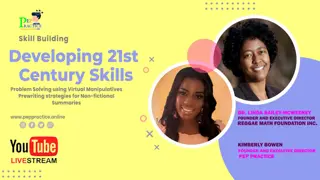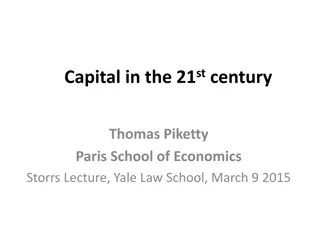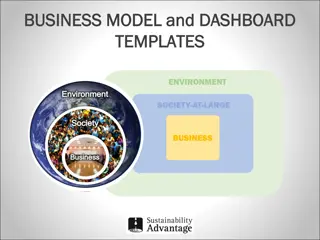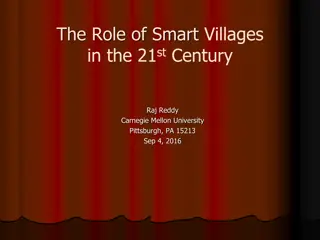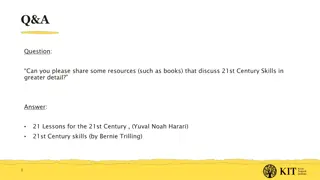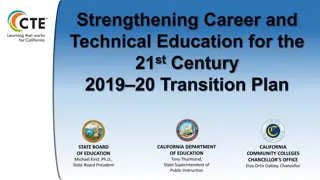PREPARING STUDENTS FOR THE 21st CENTURY
In the rapidly evolving landscape of education, it is imperative to equip students with the necessary skills to thrive in the 21st century. This includes fostering critical thinking, collaboration, adaptability, and innovation. Embracing failure as a stepping stone to innovation, questioning the status quo, and utilizing digital resources are key components in preparing students for the future. Addressing challenges such as low graduation rates and a lack of readiness for college and careers requires a shift towards teaching essential survival skills. The focus should be on empowering students to think creatively, communicate effectively, and navigate an ever-changing world with confidence.
Download Presentation

Please find below an Image/Link to download the presentation.
The content on the website is provided AS IS for your information and personal use only. It may not be sold, licensed, or shared on other websites without obtaining consent from the author.If you encounter any issues during the download, it is possible that the publisher has removed the file from their server.
You are allowed to download the files provided on this website for personal or commercial use, subject to the condition that they are used lawfully. All files are the property of their respective owners.
The content on the website is provided AS IS for your information and personal use only. It may not be sold, licensed, or shared on other websites without obtaining consent from the author.
E N D
Presentation Transcript
PREPARING STUDENTS FOR THE 21STCENTURY Learning and the Brain Conference November 2011
THE GLOBAL ACHIEVEMENT GAP BY TONY WAGNER INNOVATION EDUCATION FELLOW TECHNOLOGY & ENTREPRENEURSHIP CENTER AT HARVARD Teaching, Learning, and Leading in the 21st Century
THE NEW EDUCATIONAL CHALLENGES NEW SKILLS for Work, Continuous Learning, and Citizenship in a Knowledge Society for ALL STUDENTS Convergence of skills needed for careers, college, citizenship Students lack skills relegated to marginal employment and citizenship The NET GENERATION is differently motivated to learn Boredom is the leading cause of low achievement and student drop out The NEW PROBLEM: How to create an Innovation Nation? We cannot save or spend our way out of this crisis. The only people whose jobs cannot be automated or off- shored in a hyper connected world are the innovators
HOW DO WE STACK UP TO THE COMPETITION? Results of the 2009 PISA Test: PISA (Program for International Student Assessment) is an international study which began in the year 2000. It aims to evaluate education systems worldwide by testing the skills and knowledge of 15-year-old students in participating countries/economies. Since the year 2000 over 70 countries and economies have participated in PISA.
THE SEVEN SURVIVAL SKILLS FOR CAREERS, COLLEGE, AND CITIZENSHIP Critical Thinking and Problem-Solving Collaboration Across Networks and Leading by Influence Agility and Adaptability Initiative and Entrepreneurialism Effective Oral and Written Communication Accessibility and Analyzing Information Curiosity and Innovation 1. 2. 3. 4. 5. 6. 7.
IDEAS TO NOTE ABOUT THE SEVEN SURVIVAL SKILLS Failure needs to be viewed as a prize. There is no innovation without trial and error. We penalize our students when they fail. With no trust and respect, there is no learning. We must ask the right questions. It is not about the answers. With the Internet, knowledge is FREE. Textbooks are dinosaurs. We need more innovation We need to teach students to write with voice. Our High School graduation rate is only 70% as a nation. Students are not college and career ready when they graduate.
WHAT IS THE GLOBAL ACHIEVEMENT GAP ? The Global Achievement Gap is the gap between what even our best schools are teaching and testing Versus The skills ALL students will need for careers, college, and citizenship in the 21stcentury What gets tested gets taught: Having the wrong metric is worse than having none at all
HOW DO WE STACK UP TO THE COMPETITION? 2009 Program for Student Assessment (PISA) Test: Reading 15thout of 65 countries Science 23rdout of 65 countries Math 32ndout of 65 countries College Completion 1995 US College completion rate was number 1 in the world 2005 US College completion rate was 12thin the world. One out of 2 students who starts college never completes a degree
WHAT MOTIVATES THE NET GENERATION? Accustomed to instant gratification and always on connection Use the web for 1)extending friendships, 2)interest-driven, self-directed learning, and 3)as a tool for self-expression Constantly connected, creating, and multitasking in a multimedia world everywhere except in school Less fear and respect for authority accustomed to learning from peers; want coaching, but only from adults who don t talk down to them Want to make a difference and do interesting / worthwhile work
THE CULTURE OF LEARNING VS THE CULTURE OF INNOVATION Individual Achievement vs. Collaboration Specialization vs. Multi-disciplinary Learning Risk Avoidance vs. Trial and Error Consuming vs. Creating Extrinsic vs. Intrinsic Motivation Play, Passion, and Purpose
IMPLICATIONS FOR REINVENTION From an Information-based Learning System Focus on timeless learning (academic content that has persisted over time) To a Transformational-based Learning System Focused on using content to master the competencies of Just-in-Time Learning (What do you do with what you know?)
REDEFINING RIGOR: HABITS OF MIND LEARNING TO ASK THE RIGHT QUESTIONS Weighing Evidence How do we know what is true and false? What is the evidence, and is it credible? Awareness of Varying Viewpoints What viewpoints are we hearing? Who is the author, and what are his or her intentions? How might it look with a different history? Seeing Connections / Cause and Effect Is there a pattern? How are things connected? Where have we seen this before? Speculating on Possibilities / Conjecture What if? Supposing that? Can we imagine alternatives? Assessing Value Both Socially and Personally What difference does it make? Who cares? So what?
EVIDENCE-DRIVEN CONTINUOUS IMPROVEMENT: SOME QUESTIONS FOR TEACHERS AND ADMINISTRATORS TO CONSIDER What skills are you teaching, and how are you assessing them? What is the school doing to systematically improve instruction, and how do you know it s working? Are you a better teacher than 2 years ago if so, in what ways, and how do you know? How well are your students prepared for college, careers, and citizenship, and how do you know? Is you school adding value ? How do you know?
REDEFINING EDUCATIONAL EXCELLENCE: ACCOUNTABILITY 1. Hold Ourselves Accountable to What Matters Most Track cohort graduation rate and how well students do once they are in college Use The College and Work Readiness Assessment to assess analytic reasoning, critical thinking, problem-solving, and writing Videotape focus groups with recent grads and survey students
REDEFINING EDUCATIONAL EXCELLENCE: ACADEMICS 2. Doing the New Work: teaching & assessing the skills that matter most Develop strategies for teaching and assessing the 3C s: Critical & Creative Thinking, Communication, and Collaboration in every class and at all grade levels Pilot interdisciplinary courses around essential questions and capstone projects. Consider starting a charter-like lab school. Require all students to have digital portfolios, work internships, and service learning projects.
REDEFINING EDUCATIONAL EXCELLENCE: COLLABORATION AND TRANSPARENCY 3. Doing the New Work in NEW WAYS Isolation is the enemy of improvement and innovation (No pacing charts) Every student has an adult advocate Every teacher on teams for collaborative inquiry looking at student and teacher work Videotaping teaching and supervision (lesson study vs. evaluation) Peer-reviewed digital portfolios for teachers and administrators
DR. HELEN J. NEVILLE UNIVERSITY OF OREGON Training Brains: Improving Behavior, Cognition, and Neural Mechanisms of Attention in Lower SES Children
EXPERIENCE SHAPES HUMAN BRAIN DEVELOPMENT AND FUNCTION Brain systems are modified throughout life. The most plastic neural systems are vulnerable among individuals from lower SES backgrounds. Early environmental enrichment in the form of interventions can protect and enhance the plastic and thus potentially vulnerable neurocognitive systems in children with, or at risk for, developmental deficits.
VULNERABILITY Adults with lower language proficiency are syntax vulnerable Adults from lower SES backgrounds are syntax vulnerable Attention in children from lower SES backgrounds are attention vulnerable.
PARENT TRAINING IS NEEDED Identify known risk factors for children Stress Language Behavioral control / emotional regulation Identified evidence-based strategies / approaches for targeting each risk factor Examined literature for existing programs using these strategies / approaches
PARENT TRAINING: KEY COMPONENTS Provide high levels of positive reinforcement and specific praise Use consistent discipline with clear expectations and natural consequences Use language differently to encourage high- quality interactions Provide frequent opportunities for children to Choose, Think, and Solve Problems
EFFECTS OF PARENT TRAINING Parents changed their behaviors Parents reported reduced stress Children s language, cognition, and attention improved ChangingBrains.org
CURRICULUM 21 BY HEIDI HAYES JACOBS COLUMBIA UNIVERSITY Curriculum 21: Essential Education for a Changing World
OUR ESSENTIAL QUESTIONS: How can we prepare our learners for their future? Who owns the learning? What do we cut? What do we keep? What do we create?
WHAT YEAR ARE YOU PREPARING YOUR LEARNER FOR? We have 21stCentury children. We are currently using curriculum form about 1985. (20thCentury curriculum) Our schedule was developed in 1896 (180 days, agrarian, 6 hour day, 8 subjects)- (19thCentury schedule) Curriculum must be constantly updated. Tools must be supportive Children and youth process information differently than we do.
5 TRENDS THAT CHANGE TEACHING AND LEARNING Social Production Learning to Do Knowledge Creation Social Networks Learning to Be Defining our identities How we connect with each other determines how learning occurs (relationship, not technologies) Semantic Web Learning to Know Organizing, interpretation, connections, and distribution of information Media Grids Learning to be and do Gaming embeds to Gardner s five minds of the future Content not confined to linear structures Non-Linear Learning Disciplines are interconnected
RESISTANCE TO GROWTH The myth of the good old days Bringing back papyrus The secret in lesson planning is LAMINATION The separation of Tech and Curriculum Globalization is enrichment vs. a necessity Are we preparing our students for 2025?
BEYOND REFORM TO NEW FORMS Educational Leadership September 2009 Teaching for the 21stCentury One of the most important new forms is PERSONALIZING the GLOBAL Use 21stcentury tools to navigate teaching and learning. Abundant web resources are there for teachers and administrators: NO EXCUSES
THE GLOBAL COMPETENCY MATRIX This matrix was created as part of the Council of Chief State School Officers EdSteps Project, in partnership with the Asia Society Partnership for Global Learning. Similar matrices describing citeria for Global Competence within academic disciplines are in development. www.ccsso.org www.EdSteps.org
LITERACY Digital Literacy Media Literacy Global Literacy Cultural Literacy CURRICULUM Content Skills Assessment
CURRICULUM DESIGN REQUIRES US TO MAKE CHOICES ABOUT WHAT IS ESSENTIAL NOW TO HELP OUR LEARNERS FOR THEIR FUTURE Learners create and share knowledge differently from previous generations.
NEW SCHOOL VERSIONS The schedule Long term schedules Rethink Grade 12 compulsion Early graduation when ready Additional year if needed Summer Semester Daily instructional Time Seminars vs. Classes Study groups Rotational blocks in conjunction with set blocks (expanded block for projects, homework blocks, etc) Extended Day Patterns Staggered day different length each day Off campus time Daily Planning Time Regular cross-grade level work Regular vertical team planning Length of year: 195 205 days Rethink interior spaces
GROUPING STUDENTS Replace ability groups which focus on a child- label Focus on skills groups Homogeneous vs. Heterogeneous Long term grouping / looping clusters Vertical Teams or Looped Teams Dignity to school to work Early Graduation or Extra Year
ELEMENTARY AGE CHILDREN Developmental grouping around age spans vs. strict grade level grouping Long term grouping / looping clusters Working with pre-school educators Formal work with children and parent groups to support literacy
MIDDLE SCHOOL Team models Small group academic advisories Vertical teams Affective grouping Character Education Seminars Independent long term project outside of school
HIGH SCHOOL Recognize the different needs of adolescent learners from grades 9 12. Group around fundamental literacy skill needs / independent study skill needs Curriculum options based on motivation, aspiration, and post-secondary next steps Early graduation / extra year Science research labs Off campus requirements Dignity to school to work Vocational education Life skills Work Skills
21STCENTURY SKILLS: LEARNING FOR LIFE IN OUR TIMES BY CHARLES K. FADEL GLOBAL EDUCATION LEAD, CISCO SYSTEMS HARVARD GRADUATE SCHOOL OF EDUCATION 21stCentury Skills: The Imperative for Teaching Creativity and Innovation in Schools
CURRICULUM Make curriculum relevant Curriculum relates to late 1800 s still What will the world look like 20 years from now VUCA (Volatile, Uncertain, Complex, Ambiguity)
THE BENEFITS OF LEARNING Globalization Productivity Education Rethink Relevance, Application, Knowledge, and Skills Character
A BRAVE NEW WORLD The speed of technology is geometric. The average improvement factor is now 10,512 per year! Computer storage by 2025 will be able to video record your entire life on a smart phone. We can already store this much with cloud computing.
SO WHAT DO WE TEACH FOR. In an era of ubiquitous Watsons that give us answers? Fluidity with Technology Asking the right questions Synthesizing and Integrating Creating Interpersonal skills Adaptability Resilience
TEACHING AND LEARNING CHALLENGES WHAT is taught: Relevance (applicability, significance) to real-world (for motivation and employability) Skills, not just Knowledge (critical thinking, creativity, etc) Schooling vs. Real-World school learning is abstract, theoretical, and organized by disciplines while work is concrete, specific to the task, and organized by problems and projects Organisation for Economic Co-operation and Development (OECD), Learning for Jobs 2009
21STCENTURY SKILLS FRAMEWORK Core Subjects Native Language / Reading World Languages incl. English Arts Geography History Mathematics Science Government / Civics 21stCentury Themes Global Awareness Financial, Econonic, Business and Entrepreneurial literacy Civic Literacy Health Literacy Environmental Literacy
21STCENTURY SKILLS FRAMEWORK Learning and Innovation Skills Critical Thinking and Problem Solving Creativity and Innovation Communication and Collaboration Information, Media, and Technology Skills Information Literacy Media Literacy ICT (Information, Communications, and Technology) Literacy Life and Career Skills Flexibility and Adaptability Initiative and Self-Direction Social and Cross-Cultural Skills Productivity and Accountability Leadership and Responsibility
YOUR CREATIVE BRAIN: SEVEN STEPS TO MAXIMIZE IMAGINATION, PRODUCTIVITY, AND INNOVATION IN YOUR LIFE BY SHELLEY CARSON Creative Brains: Maximizing Imagination and Innovation in Students
THE CREATIVE PROCESS Preparation (gathering knowledge Problem Finding) Creative Solution (hardest part) Evaluation of the solution(s) Elaboration Implementation Get it in the workd in some way We need to learn broadly from multiple fields and explore new ways things can be done.
CREATIVE SOLUTIONS Trial and Error Deliberate creativity Deliberate pathway to test novel ideas (Edison s light bulb experiments) Failure is part of the process and is VERY important The more ideas you generate, the more likely you will be to succeed. Incubation and Insight (Aha!) Comes with a conviction that you are right Still must be tested
